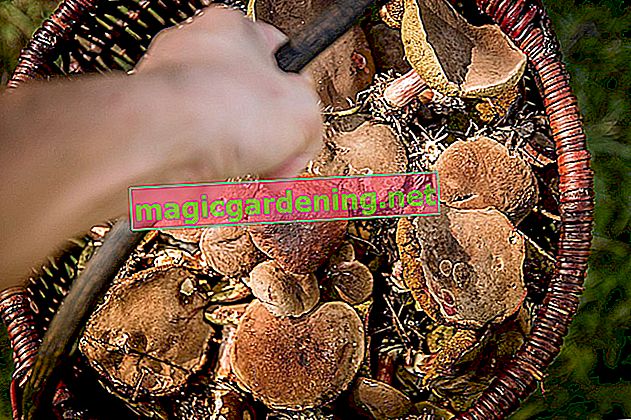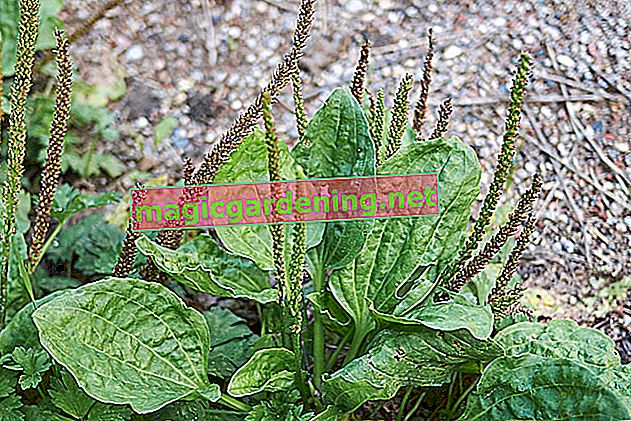
Types of cuts with time
When phloxes transform the perennial bed into a summer sea of flowers, they vie for the favor of insects. The only goal of the brightly colored flower umbels is to pollinate as quickly as possible, so that numerous seeds for the floral offspring emerge from it. There is disagreement between phlox and gardener in this regard, because the latter want a never-ending flowering time without the hassle of self-sowing. Different types of pruning direct the growth and flowering of flame flowers in the desired direction. The following table summarizes all cutting options together with tips on the best time:
also read
- How to properly prune an apple tree - tutorial with lots of instructions
- Cutting hornbeam as a tree and bush - tutorial with lots of instructions
- Correctly cut walnut tree - cutting tutorial with instructions
| Cut type | Goal / occasion | best time |
|---|---|---|
| Clean up withered inflorescences | Promote autumn re-blooming | shortly before the end of the first flower pile |
| Chelsea cut | Extension of the flowering period | Mid to late May, before flowering begins |
| Order-creating cut back | Preparation for winter time | Late autumn, beginning of winter |
| gentle pruning | Clear the bed for this year's budding | Mid-April to early May |
| Rejuvenation by division | revitalize old phlox | Late autumn or early spring |
| Vase cut | Cut flowers for the vase | during the flowering period |
Cleaning out phlox - instructions for remounting
Phloxes belong to the illustrious perennial society whose members are encouraged to re-bloom. The floral masterpiece is called “remounting” in technical jargon. In concrete terms, this means that the flowers build up again after pruning and bloom again. Instead of investing energy in the growth of seed heads, many Phlox species do a lot of hard work and extend the flowering period. This is how the correct replacement cut succeeds:
- The best time is shortly before the end of the first flower pile
- As soon as the first single flowers of an umbel wilt, it is cut
- Place scissors over the next healthy pair of leaves
The illustration below shows the best time and the right interface. It is undoubtedly a considerable effort to cut off partially blooming phlox umbels. Nonetheless, don't wait for all of the plate-shaped flowers to wilt. At this point, seed pods have already started to form and your phlox lacks the energy reserves for a re-bloom.

This is how the Chelsea cut works
In addition to regular cleaning, you can noticeably extend the flowering period with a tried and tested pruning method. A skilful cut before the start of flowering has a positive effect on the overall duration. The Chelsea cut - also known as the Chelsea Chop - is not just intended to extend the flowering period. At the same time, a phlox is stimulated to develop richly branched, bushy growth with numerous flower buds. How to cut properly:
- The best time is between the end of May and the beginning of June before the flowering period begins
- Cut back the outer stems of a phlox by a third
- Optionally shorten all stems or a part
With the original Chelsea cut, the outer stems of all perennials are cut back. As a result of the cut, each phlox develops new side shoots and grows bushier. The flowering time is postponed by four to six weeks because the buds along the cut shoots form and open with a delay.
Can you not bring yourself to the radical approach? Then we recommend pruning the stems in the front perennial area. As a result, withered, bare stems are concealed within the center of the plant during the summer when the late bloomers bloom in the foreground.
background
Bypass or anvil scissors?
All efforts to achieve the perfect Chelsea Chop or remounting cut on phlox are wasted if unsuitable cutting tools are used. Leaving the stems cut and bruised, you will look in vain for the bright umbels. One-hand secateurs with a bypass mechanism are well suited for smooth cuts. The scissors work with two sharp blades that move past each other. In contrast, anvil scissors are equipped with a sharp blade and a blunt opposite side, the anvil. The mechanism reduces the effort required, but carries the risk of pinched shoots. When it comes to cutting herbaceous flower stems on a flame flower, bypass scissors are clearly ahead.Cut phlox in autumn
Gardeners traditionally cut dead perennials in autumn. The measure ensures order in the bed and functions as preparation for the next shoot in spring. In order for colorful dabs of fresh flame flowers to appear in the garden as early as possible, all disused parts of the plant must give way. How to properly prune phlox in autumn:
- The best time is before the onset of winter
- Grasp dried flower stems in bunches with one hand
- Bend the tufts to one side
- Take the knife or garden sickle in the other hand
- Cut the phlox stems hand-widthwise from the ground
Cuttings from healthy flame flowers are ideally suited as mulch, (€ 213.00 on Amazon *) to feed the soil life together with compost. Leave the shoots and leaves on the bedding soil after the autumn cut. A variety of insects know how to use the remains as shelter during the cold season. In the course of decomposition, dead phlox stems release valuable nutrients into the ground, where busy microorganisms make them available for the next generation of plants.

Digression
Garden sickle for skilful pruning
The curved cutting edge glides effortlessly through dead perennial stems. The sickle cuts even small branches in next to no time. The garden sickle works more effectively than conventional secateurs and more precisely than any hedge trimmer. (€ 135.56 at Amazon *) At first glance, the cutting tool is reminiscent of a scythe that is too small. In fact, it is an import from Japan, where the perennial sickle is traditionally used to cut bamboo, thin branches, grasses and shrubs. The blade is razor-sharp and has a self-sharpening fluted edge. At the same time, the risk of injury to the gardener is low, because cutting is only done on pull. The blade of a perennial sickle does not cut when pressed.Spring cut - gentle on nature
In spring one can see a big difference between populated areas and the great outdoors. While in carefully tended gardens at the end of winter green tones dominate with the first splashes of color early flowering plants, in the kingdom of mother nature beige and brown tones predominate. Dead stems in which the wintering insects prepare for spring stand on meadows and wild perennial areas. The seed heads from the previous year are a valuable source of food for native and returning songbirds.
In the wild, the colors of spring arrive much later. Dry perennial stems still have important tasks to perform beforehand. Only when spring storms and an awakening animal world have broken most of the stems in April does the young green gradually take hold.
Gardeners who are close to nature give a lot of space to natural growth and decay. The perennial cut is only on the schedule from April - completely in harmony with nature. For your phlox, this has the beneficial side effect that dead shoots and leaves reliably protect the rootstock in the ground from moisture and frost during winter. The first centimeters of young shoots benefit from this protection when the late frosts in March and April surprise.
The only difference between gentle spring pruning and courageous autumn pruning is a careful approach. Cut off dead plant parts above green young shoots if they have already ventured out of the earth. At this stage, cutting is usually no longer necessary. The process of dissolving the shoots from the previous year has progressed so far that the stems will detach by themselves if you pull on them with your fingers.
Old phlox rejuvenate by dividing
Over the years, a phlox loses its vitality and ability to flower. Don't just accept stagnant abundance of flowers on your flame flower. By extending the pruning to a division of the root ball, you bring fresh momentum to growth. The method is particularly suitable for the high flame flower (Phlox paniculata) and the varieties that emerge from it. A perennial can best cope with the procedure during dormancy. How to rejuvenate an ancient phlox by division:
- Time window is open in autumn (November) and spring (March / April)
- Cut back dead shoots to a hand's breadth above the bedding soil
- Cut off the root ball in a circle with a spade
- Push the spade under the rhizome and loosen it by moving it up and down
- Lift the bale out of the earth and place it on a firm surface
The division works perfectly with a straight spade blade. Divide the root ball in half. You can divide a very large rootstock into four segments, provided that each section has at least 6 to 8 shoots. In a sunny location with fresh, moist and nutrient-rich soil, plant each phlox piece in such a way that the previous planting depth is maintained. Enrich the soil in the planting hole with compost and horn shavings (€ 6.39 at Amazon *) to promote the rooting. In the following period, water regularly and abundantly. A positive side effect of the makeover is an increase for free.
Cut phlox for the vase
A phlox won't hold it against you if you cut off a few flower stems for a colorful bouquet. Properly cut and inserted, the fragrant flower heads stay fresh in a vase for up to 12 days. The best time to cut the vase is during the morning when the morning dew has evaporated. Choose umbels whose first flowers have already unfolded. Cut a flower stem at an angle at the lower end. Remove the leaves where a stem will later be in the water. Phlox shows its most beautiful side as a vase jewelry in room warm water, which is changed daily.
frequently asked Questions
Powdery mildew is spreading on my phlox - what to do?
Powdery mildew is one of the most common plant diseases that affect phlox. The fungal infection is transmitted by the wind, rain and irrigation water drops and unclean scissors. An unmistakable symptom is a floury-gray fungal lawn that spreads on the leaves and shoots. Immediately cut off infected parts of the plant and dispose of the remains in the household waste. To prevent further spread, treat diseased phlox and neighboring plants with environmentally friendly network sulfur or the tried and tested household remedy made from one liter of water and one eighth liter of fresh milk.
Will the Tall Flame Flower be pruned immediately after flowering in September?
Large-flowered phlox will usually give you a second bloom if you cut back the perennial after the main bloom. The best time is when the first petals on the umbel wither. If you cut over the next healthy pair of leaves, the buds located deeper are activated and bloom within a short time.
I cut back my high phlox after the flowering period. Should I fertilize the perennial again in August? If so, is compost suitable or is blue grain better?
If the high flame flower is fertilized with a concentrated load of nitrogen in autumn, the perennial is lost in winter. Fertilizers, such as blue grain, triggered a vigorous growth that makes phlox vulnerable to the first frost. Give your phlox time to mature from August through winter. The flowers in the garden are only fertilized with compost and horn shavings from budding until the end of July at intervals of 2 weeks. Alternatively, you can give a single slow release fertilizer, such as blue grain, in May.
Should I cut back the Carpet Flame Flower after it's flowering?
Small phlox species and varieties do not need pruning. Just let the Carpet Flame Flower (Phlox douglasii) continue to grow. In winter, the above-ground parts of the plant die, clearing the way for renewed flowering in the next year.
My phlox suffered from powdery mildew all summer long, which I repeatedly fought with fungicides. Now the flowering period is over and powdery mildew is spreading again. Should I use the mushroom remedy again or cut off the plant?
As autumn is just around the corner, the perennial is slowly retreating. It is therefore advisable to cut back the infected parts of the plant to a hand's breadth above the ground. It is important to note that you do not throw the clippings on the compost. Please dispose of the shoots in the household garbage can or burn them in the fire basket. At this point in time you will no longer achieve any control success with fungicides.
The 3 most common mistakes
When the flowering period comes to an early end, efforts to re-bloom come to nothing, or Phlox disappoints with puny blooms, there is a classic oversight. To save you from such annoyances, the following table lists the three most common cutting errors with tips for successful prevention:
| Cutting errors | Damage | prevention |
|---|---|---|
| no replacement cut | No splendid second bloom | Cut off dead flowers |
| cleaned too late | no re-bloom | Start re-cutting when the first single flowers of an umbel wilt |
| Phlox never recorded and shared | steadily decreasing flowering capacity | rejuvenate every few years by division |
Tips
Flame flowers should not be missing in the insect-friendly garden. The glowing flowers of phlox are a popular destination for butterflies. Swallowtail, aurora butterflies and Co. don't care that the perennials are native to distant North America. The main thing is that the opulent perennials thrive with unfilled flowers so that bees, bumblebees and butterflies can feast on their rich buffet of nectar and pollen.








